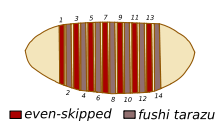Pair-rule gene

A pair-rule gene is a type of gene involved in the development of the segmented embryos of insects. Pair-rule genes are expressed as a result of differing concentrations of gap gene proteins, which encode transcription factors controlling pair-rule gene expression.[1][2] Pair-rule genes are defined by the effect of a mutation in that gene, which causes the loss of the normal developmental pattern in alternating segments.
Pair-rule genes were first described by Christiane Nüsslein-Volhard and Eric Wieschaus in 1980.[3] They used a genetic screen to identify genes required for embryonic development in the fruit fly Drosophila melanogaster. In normal unmutated Drosophila, each segment produces bristles called denticles in a band arranged on the side of the segment closer to the head (the anterior). They found five genes – even-skipped, hairy, odd-skipped, paired and runt – where mutations caused the deletion of a particular region of every alternate segment. For example, in even-skipped, the denticle bands of alternate segments are missing, which results in an embryo having half the number of denticle bands. Later work identified more pair-rule genes in the Drosophila early embryo – fushi tarazu, odd-paired and sloppy paired.[4]
Once the pair-rule genes had been identified at the molecular level it was found that each gene is expressed in alternate parasegments – regions in the embryo that are closely related to segments, but are slightly out of register.[5][6][7][8] Each parasegment includes the posterior part of one (future) segment, and an anterior part of the next (more posterior) segment. The bands of expression of the pair-rule genes correspond to the regions missing in the mutant. The expression of the pair-rule genes in bands is dependent both upon direct regulation by the gap genes [9] and on regulatory interactions between the pair-rule genes themselves.[10]
See also
References
- ↑ Gilbert, SF (2000). Developmental Biology (6th ed.). Sunderland (MA): Sinauer Associates. pp. The Origins of Anterior–Posterior Polarity. Retrieved 23 October 2015.
- ↑ "Segmentation Genes in Drosophila Development: Pair Rule, Segment Polarity & Gap Genes". Study.com. Retrieved 23 October 2015.
- ↑ Nüsslein-Volhard C, Wieschaus E (October 1980). "Mutations affecting segment number and polarity in Drosophila". Nature. 287 (5785): 795–801. PMID 6776413. doi:10.1038/287795a0.
- ↑ Wakimoto BT, Kaufman TC (January 1981). "Analysis of larval segmentation in lethal genotypes associated with the antennapedia gene complex in Drosophila melanogaster". Dev. Biol. 81 (1): 51–64. PMID 6780397. doi:10.1016/0012-1606(81)90347-X.
- ↑ Hafen E, Kuroiwa A, Gehring WJ (July 1984). "Spatial distribution of transcripts from the segmentation gene fushi tarazu during Drosophila embryonic development". Cell. 37 (3): 833–41. PMID 6430568. doi:10.1016/0092-8674(84)90418-5.
- ↑ Ingham, P. W.; K. R. Howard & D. Ish-Horowicz (1985). "Transcription pattern of the Drosophila segmentation gene hairy". Nature. 318: 439–445. doi:10.1038/318439a0.
- ↑ Macdonald PM, Ingham P, Struhl G (December 1986). "Isolation, structure, and expression of even-skipped: a second pair-rule gene of Drosophila containing a homeo box". Cell. 47 (5): 721–34. PMID 2877745. doi:10.1016/0092-8674(86)90515-5.
- ↑ Lawrence PA, Johnston P, Macdonald P, Struhl G (1987). "Borders of parasegments in Drosophila embryos are delimited by the fushi tarazu and even-skipped genes". Nature. 328 (6129): 440–2. PMID 2886916. doi:10.1038/328440a0.
- ↑ Ingham, P. W.; Ish-Horowicz, D. & Howard, KR (1986). "Correlative changes in homoeotic and segmentation gene expression in Krüppel mutant embryos of Drosophila". The EMBO Journal. 5 (7): 1659.
- ↑ Howard K . & Ingham P. "Regulatory interactions between the segmentation genes fushi tarazu, hairy, and engrailed in the Drosophila blastoderm". Cell. 44 (6): 949–957. doi:10.1016/0092-8674(86)90018-8.
External links
- The Interactive Fly: http://www.sdbonline.org/fly/aignfam/gapnprl.htm